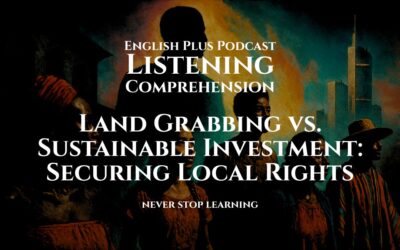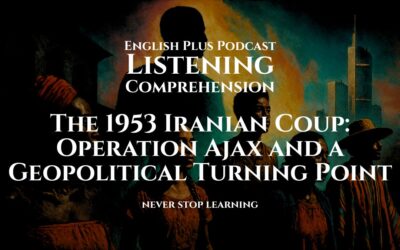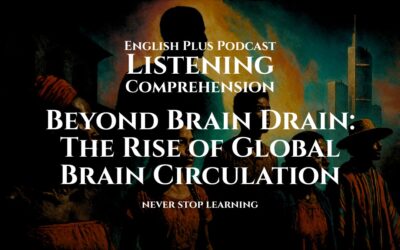Get Ready to Listen
Welcome! This exercise is designed to feel just like the listening sections of major international English exams. You’ll listen to a short academic lecture and then answer questions about it. The goal is to improve your ability to understand main ideas, specific details, and a speaker’s purpose in a formal setting.
Here are a few tips to help you succeed:
- Predict the Content: The topic is “Migration and Refugee Crises.” Before you even listen, think about what you already know. What causes people to leave their homes? What challenges do they face? This warms up your brain and helps you anticipate the vocabulary.
- Listen for the Structure: Pay attention to “signposting language.” Phrases like “First, let’s consider…”, “Another key factor is…”, or “In conclusion…” are clues that tell you where the lecture is heading.
- Take Smart Notes: You don’t need to write down every word. Focus on main ideas, key terms, and examples. Use abbreviations and symbols to be quick (e.g., Ppl for people, → for ‘leads to’).
- Don’t Get Stuck: If you miss a word or a detail, don’t panic! Keep listening to the main flow of the lecture. You can often understand the overall meaning even if you miss a few pieces of information.
Ready? Let’s begin.
Listening Audio
Listening Transcript: Please do not read the transcript before you listen and answer the questions.
Good morning, everyone. In today’s lecture, we’re going to delve into one of the most pressing and multifaceted issues of our time: global migration and the associated refugee crises. It’s a topic we see in the news daily, yet the terminology and the underlying dynamics can often be complex. Our goal today is to unpack this complexity by examining the core causes of mass human movement and then analyzing its profound consequences, both for the individuals who move and for the societies that receive them.
First, it’s crucial to establish a clear distinction between terms. While often used interchangeably, ‘migrant’ and ‘refugee’ have distinct legal definitions. A migrant is broadly defined as someone who moves from their home for any reason, often for economic opportunity or education. A refugee, on the other hand, is a person who has been forced to flee their country because of persecution, war, or violence. A key element for a refugee is a well-founded fear of persecution. Related to this is the term ‘asylum seeker,’ which refers to someone who has sought protection as a refugee but whose claim has not yet been definitively evaluated. This legal distinction is vital because it determines the rights and protections an individual is entitled to under international law.
So, what compels millions of people to undertake these often perilous journeys? The reasons can be broadly categorized into ‘push’ factors and ‘pull’ factors. ‘Push’ factors are the negative conditions that provide the impetus for people to leave their homes. The most salient of these is conflict. The Syrian Civil War, for example, triggered one of the largest refugee crises of the 21st century, displacing millions both internally and externally. Persecution, whether based on ethnicity, religion, or political opinion, is another powerful push factor.
Beyond conflict, economic hardship is a massive driver of migration. Lack of employment opportunities, poverty, and economic instability can make life untenable, pushing individuals to seek better prospects elsewhere. Increasingly, we are also seeing the rise of environmental factors. Climate change is no longer an abstract threat; it’s a concrete reality. Prolonged droughts, rising sea levels, and catastrophic natural disasters are rendering entire regions uninhabitable, forcing populations to move in search of survival. These individuals are often referred to as ‘climate refugees,’ though this is not yet a formal legal category.
On the other side of this dichotomy are the ‘pull’ factors—the perceived advantages of a destination country that attract people. These often mirror the push factors. A country with a stable political system and a strong rule of law is a powerful magnet for those fleeing conflict and instability. The prospect of economic prosperity, access to better education and healthcare, and the possibility of joining family members already established abroad—a process known as family reunification—are all significant pull factors. It’s important to understand that a person’s decision to move is rarely based on a single factor, but rather a complex interplay of these push and pull dynamics.
Now, let’s turn our attention to the consequences, which are just as complex as the causes. For host countries, the arrival of large numbers of migrants and refugees can present both challenges and opportunities. One of the immediate challenges is the strain on social services. Schools, healthcare systems, and housing infrastructure can be stretched thin, particularly if the influx is sudden and large-scale. There can also be social tensions as communities adapt to new cultures and demographics.
However, the economic ramifications are not solely negative. Migrants often fill critical labor shortages, particularly in agriculture, construction, and healthcare. They start businesses at higher rates than native-born citizens, creating jobs and stimulating economic growth. Furthermore, immigration brings cultural enrichment, introducing new foods, traditions, and perspectives that can invigorate a society. The narrative is rarely as simple as ‘burden’ versus ‘benefit’; it is almost always a nuanced blend of both.
For the refugees and migrants themselves, the journey and its aftermath are fraught with difficulty. The physical journey can be incredibly dangerous, and upon arrival, they often face significant barriers. These include learning a new language, navigating complex bureaucratic systems, and dealing with discrimination or xenophobia. The psychological toll, especially for refugees who have experienced trauma, can be immense. Yet, for all these hardships, the ultimate consequence can be the chance at a new life—one of safety, stability, and opportunity for themselves and their children. The resilience and determination shown by these individuals are truly remarkable.
In conclusion, migration and refugee crises are not simple phenomena with easy solutions. They are the result of a tangled web of global inequalities, conflicts, and environmental pressures. Understanding this issue requires us to look beyond sensational headlines and appreciate the legal distinctions, the diverse causes, and the wide-ranging consequences for everyone involved. International cooperation and compassionate, evidence-based policies are paramount if we are to manage this enduring feature of our interconnected world.
Listening Quiz
Keywords & Phrases
- Multifaceted
- What it means: Having many different parts or aspects. It’s a great synonym for “complex” or “complicated.”
- In the lecture: The speaker calls the refugee crisis a “multifaceted issue” to emphasize that it has many sides—economic, social, political, and environmental.
- Persecution
- What it means: Hostile and unfair treatment, especially because of race, political beliefs, or religion.
- In the lecture: This is used to define a key reason why someone is a refugee. They must have a “well-founded fear of persecution.”
- Asylum Seeker
- What it means: A person who has left their home country as a political refugee and is seeking protection (asylum) in another.
- In the lecture: The speaker defines this term to distinguish it from a refugee whose claim has already been approved. An asylum seeker is in the process of being recognized as a refugee.
- Impetus
- What it means: The force or energy that makes something happen or happen more quickly. It’s a formal word for “motivation” or “stimulus.”
- In the lecture: Push factors are described as providing the “impetus for people to leave their homes.”
- Salient
- What it means: Most noticeable or important. It’s a sophisticated way to say “main” or “primary.”
- In the lecture: Conflict is described as the “most salient” push factor, meaning it’s one of the most significant and obvious causes of refugee crises.
- Untenable
- What it means: Not able to be maintained or defended against attack or objection. In a practical sense, it means a situation is impossible to continue.
- In the lecture: Economic hardship can make life “untenable,” meaning it becomes impossible for people to continue living in their home country.
- Dichotomy
- What it means: A division or contrast between two things that are or are represented as being opposed or entirely different.
- In the lecture: The speaker refers to the “dichotomy” between push and pull factors—the two opposite forces that drive migration.
- Strain on social services
- What it means: This phrase describes the pressure placed on public systems like healthcare, schools, and housing when there is a sudden increase in population.
- In the lecture: This is mentioned as one of the primary challenges that host countries face when receiving a large number of refugees.
- Ramifications
- What it means: The complex and often unwelcome consequences of an action or event. It’s a synonym for “consequences,” but often implies that they are far-reaching and indirect.
- In the lecture: The economic “ramifications” are described as being both positive and negative, highlighting the wide-ranging effects.
- Paramount
- What it means: More important than anything else; supreme.
- In the lecture: The speaker concludes that international cooperation is “paramount,” meaning it is absolutely essential to managing the global migration crisis.











0 Comments